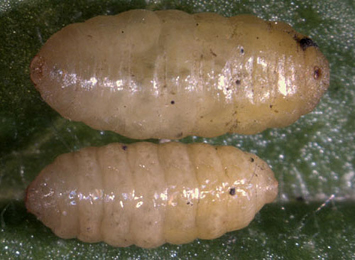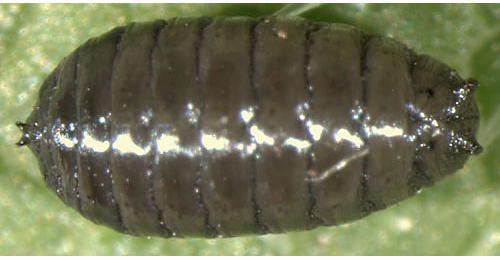|
||||||
|
PIMPINELLA. Saxifrages. [Apiaceae] |
|
Five species of Pimpinella are recorded in Britain. These include the native Greater Burnet-saxifrage (P. major) and Burnet-saxifrage (P. saxifraga). Ten British miners are recorded on Pimpinella. The agromyzid Melanagromyza sativae bores the stems of Pimpinella and other Apiaceae in Britain and elsewhere. A key to the European miners recorded on Pimpinella is provided in Bladmineerders van Europa. |
Key for the identification of the known mines of British |
Note: Diptera larvae may live in a corridor mine, a corridor-blotch mine, or a blotch mine, but never in a case, a rolled or folded leaf, a tentiform mine or sandwiched between two more or less circular leaf sections in later instars. Pupation never in a cocoon. All mining Diptera larvae are leg-less maggots without a head capsule (see examples). They never have thoracic or abdominal legs. They do not have chewing mouthparts, although they do have a characteristic cephalo-pharyngeal skeleton (see examples), usually visible internally through the body wall. The larvae lie on their sides within the mine and use their pick-like mouthparts to feed on plant tissue. In some corridor miners frass may lie in two rows on alternate sides of the mine. In order to vacate the mine the fully grown larva cuts an exit slit, which is usually semi-circular (see Liriomyza huidobrensis video). The pupa is formed within the hardened last larval skin or puparium and as a result sheaths enclosing head appendages, wings and legs are not visible externally (see examples). See Key to non-Diptera. |
1a > Leaf-miner: A large blotch, yellow or brown, preceded by a short corridor that in the end mostly is completely overrun. Generally several larvae share a mine. Especially in fresh mines the green primary and secondary feeding lines are well visible. Pupation outside the mine. Puparium yellow. |
 Euleia heraclei pupariria Image: © Willem Ellis (Bladmineerders van Europa) |
|
Euleia heraclei (Linnaeus, 1758) [Diptera: Tephritidae]. |
1b > Leaf-miner: A small regular blotch, which can be enlarged when several larvae feed together (Spencer, 1972b: 105 (fig. 360, putative mine on Pimpinella saxifraga), 466; Spencer, 1976: 465 (fig. 816, mine on Peucedanum oreoselinum). Roundish, upper-surface blotch, about 1 cm in diameter. No trace of a preceding corridor. Frass in coarse grains. Pupation outside the mine; exit slit in upper epidermis. |
|
Phytomyza pauliloewii Hendel, 1920 [Diptera: Agromyzidae]. |
1b > Leaf-miner: A relatively short and broad upper linear-blotch surface mine (Spencer, 1972b: 76 (fig. 255), 80; Spencer, 1976: 468, 469 (Fig. 825)). Elongated upper-surface blotch with conspicuous primary feeding lines. Frass partly in pear strings. Pupation outside the mine (Spencer, 1954a). |
|
Phytomyza pimpinellae Hendel, 1924 [Diptera: Agromyzidae]. |
1c > Leaf-miner: A linear mine rigidly following the margin of the leaf segment (Spencer, 1976: 369). A long, narrow, upper-surface initial corridor, starting in the centre of a leaflet, that suddenly widens. The wider later corridor closely follows the leaf margin. Frass in irregularly dispersed granules. |
|
Phytomyza adjuncta Hering, 1928 [Diptera: Agromyzidae]. |
1d > Leaf-miner: A short linear mine which considerably widens towards the end, normally starting in the centre of the leaf. Puparium black |
|
Phytomyza melana Hendel, 1920 [Diptera: Agromyzidae]. |
1e> Leaf miner: A regular greenish inter-parenchymal blotch mine, frequently delimited by two veins, appearing somewhat mottled as a result of small deeper areas of feeding through the upper parenchyma (Spencer, 1972b: 78 (fig. 259); Spencer, 1976: 428, 429 (fig. 748). The mine starts with a quite inconspicuous lower-surface corridor that soon changes into an extensive interparenchymatous blotch. The upper cell layer of the palisade parenchyma is eaten away in many places, giving the mine in transparency a perforated appearance. Fresh mines are pale green, later they turn brown; they give the leaves a strikingly diseased impression. Feeding lines absent, frass grains strikingly few. Larvae solitary. Pupation outside the mine, exit slit in lower epidermis. Forms a blotch mine between two veins, having a characteristic sieve-like appearance (where the larva has fed through the upper parenchyma). Pupation outside the mine.. |
 Phytomyza heracleana puparium Image: © Willem Ellis (Bladmineerders van Europa) |
|
Phytomyza heracleana Hering, 1937 [Diptera: Agromyzidae]. |
1f > Leaf-miner: A large blotch, yellow or brown, preceded by a short, in the end mostly unrecognisable corridor. Generally several larvae in the mine. Especially in fresh mines the green primary and feeding lines area well marked. Pupation outside the mine. |
|
Cryptaciura rotundiventris (Fallén, 1814) [Diptera: Tephritidae]. |
|
Key for the identification of the known mines of British |
Note: The larvae of mining Coleoptera, Hymenoptera and Lepidoptera may live in a corridor mine, a corridor-blotch mine, a blotch mine, a case, a rolled or folded leaf, a tentiform mine or sandwiched between two more or less circular leaf sections in later instars. Larva may pupate in a silk cocoon. The larva may have six legs (although they may be reduced or absent), a head capsule and chewing mouthparts with opposable mandibles (see video of a gracillarid larva feeding). Larvae of Hymenoptera and Lepidoptera usually also have abdominal legs (see examples). Frass, if present, never in two rows. Unless feeding externally from within a case the larva usually vacates the mine by chewing an exit hole. Pupa with visible head appendages, wings and legs which lie in sheaths (see examples). |
1a > Leaf-miner: In the first instar the larva mines the leaves, forming short, irregular, blotch-like mines, but in later instars it lives externally, feeding in spun leaves and often twisting those of tender shoots. Larval head light-brown or yellowish brown, edged with black postero-laterally, ocellar area blackish; prothoracic plate black edged with whitish anteriorly; abdomen dull dark green; pinacula distinct, black, sometimes brownish but with black bases to setae; anal plate large, black (Bradley et al., 1973). Small, full depth mine without a definite shape; little frass. Some silk is deposited in the mine. The larva soon leaves the mine and continues feeding among spun leaves. |
|
| Cnephasia incertana (Treitschke, 1835) [Lepidoptera: Tortricidae]. |
1b > Leaf-miner: Young larvae make small, full depth blotch mines, almost without frass. Older larva live externally on the plant under a light web. Initially forms a small blotch mine and may later feed in a slight web. In coastal areas may continue mining throughout the larval stage. |
|
Epermenia aequidentellus (Hofmann, 1867) [Lepidoptera: Epermeniidae]. |
1c > Leaf-miner: The larvae are often gregarious and feed on the underside of the leaf causing a 'windowing' effect as they eat the mesophyll and lower epidermis. This effect can be seen from the top of the leaf as it discolours. Short, small, irregular, sometimes widened corridor. Mostly a number in a leaf, concentrated in the axils of the midrib and the primary side veins. Each larva makes a number of mines. Often the larva protrudes with its rear end out of the mine, causing most frass to be ejected. While moving, at the leaf underside, silken threads are produced, in wich grains of frass may be trapped. Older larvae live free and cause window feeding, often in a group under a light spinning. |
|
Epermenia chaerophyllella (Goeze, 1783) [Lepidoptera: Epermeniidae]. |
| Last updated 06-Jul-2019 Brian Pitkin | ||
